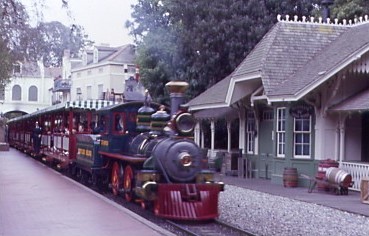
I had not been to Disneyland since 1993 when I worked at McArthur Fundamental Intermediate School and took the eighth graders there on their promotion trip. I always wondered what the Indiana Jones ride would be like but never visited the park again. Disneyland opened the California Adventure with a Western Pacific California Zephyr made-up train set so I was interested in seeing that. My dear friend Jeff Hartmann worked for Disney and tested video games for years. In fact, he had been an employee long enough that he could now bring someone into either park for free.
Jeff asked me when I would like to go and we chose a date. Following a round-trip to Solana Beach on a Pacific Surfliner train, Jeff picked me up and we were off to the Magic Kingdom and California Adventure.
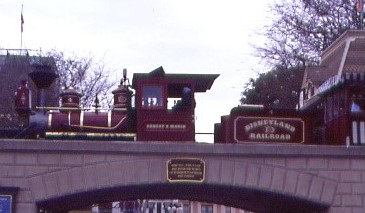
We were greeted by the train at the Main Street station and took the horse car down Main Street America before going to the Indiana Jones ride, which we both enjoyed after only a thirty minute wait. What a great ride! Next we went to Pirates of the Caribbean, which I really enjoyed after the seeing the film. Nextwe went to the New Orleans Square station to wait for the trains to pass.
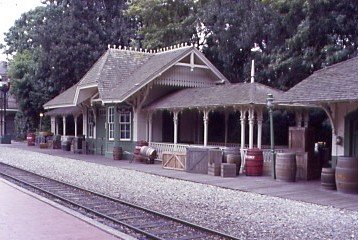
The New Orleans Square station area.
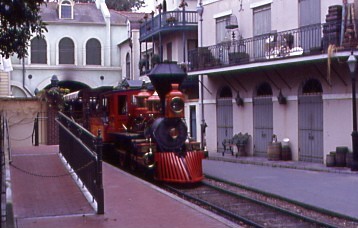
Disneyland Railroad 4-4-0 1 "Cyrus K. Holliday" built in 1955 by Disney Studios/Dixon Boiler arrived at the station.
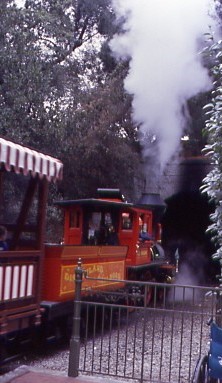
The steam train departing and proceeding to a tunnel.

Disneyland Railroad 36" gauge 4-4-0 2 "E.P. Ripley" built by WED Enterprises in 1955. It was named after Edward Payson Ripley (1845-1920), the first President of the re-organized Atchison, Topeka & Santa Fe Railway in 1895.
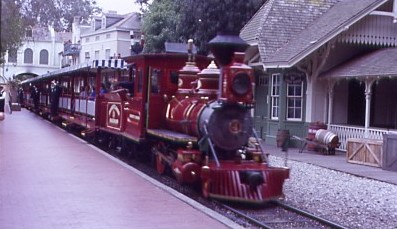
Arriving next was Disneyland Railroad 2-4-0 4 "Ernest S Marsh", built by Baldwin in 1925 as Raritan Sand Company 10 in Nixon, Newe Jersey. It was sold to a scrap dealer in Newark, New Jersey before being sold to the Pine Creek Railroad in Freehold, New Jersey in 1952. In 1957, it was leased to the Cranberry Creek Railroad before being sold in 1958 to W.E.D. Enterprises.
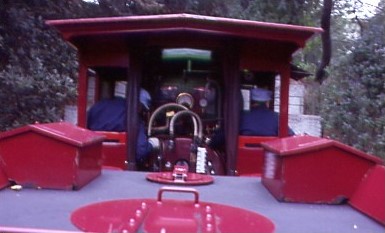
A view into the cab of Disneyland Railroad 4. We then rode the train all the way around the park before detraining at the Toontown station and walked over to the Monorail.
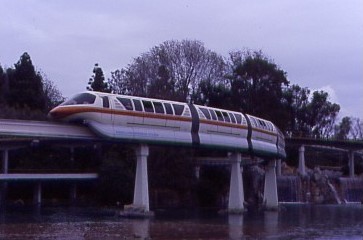

The Monorail coming and going through Tomorrowland. Walt Disney originally envisioned the monorail as a practical form of public transport for the future. However, the technology would never catch on in the United States. The monorail came about during a time when America's - and particularly Los Angeles' - obsession with the automobile was increasing, and monorails in the United States were mostly only located in Disney's theme parks.
The job of building the monorail was originally assigned to the Standard Carriage Works of East Los Angeles, but in late 1958, Walt Disney, pressured for time, moved it to his Burbank studios. Disney designer Bob Gurr then headed a Disney team that designed and manufactured the cars, chassis, suspension and propulsion systems. Gurr and Disney were assisted by Alweg, the German company that pioneered straddle beam monorails. The Disneyland Alweg Monorail System opened on June 14, 1959, just in time for the re-dedication of Tomorrowland and a broader expansion of Disneyland which included the Matterhorn Bobsleds, the Submarine Voyage, the expanded version of Autopia and the Motor Boat Cruise. The Mark I trains (Red and Blue) consisted of three cars each. The opening ceremony was attended by then-Vice President Richard Nixon and his family.
At opening, the monorail was merely an attraction, taking people on a scenic trip around Disneyland before returning to its only station. In 1961, it became a true transportation system when the track was extended two-and-a-half miles miles outside the park to a second station near the Disneyland Hotel. As part of this project, the Tomorrowland station was lengthened to accommodate four-car Mark II trains and a third Yellow train was added. From Hotel Station, there were two trips above Disneyland available aboard the monorail, a quick tour and general admission. Guests wishing to embark upon a vista-dome view of the park, including a leisurely layover in Tomorrowland within the tail-cone could purchase an exclusive round-trip tour ticket at Hotel Station and save the expense of general admission to Disneyland. Nose and tail-cone door latches were independent of the main door release button. A simple dial indicator above the tail-cone compartment door could be turned to one of three positions—General admission guests, round-trip only guests, and mixed. Hostess attendants at Tomorrowland Station would check the dial position and open the door for general admission guests. If general admission guests boarded the tail-cone in Tomorrowland, the dial would be set to mixed, then all mixed tail-cone guests disembarked at the hotel.
Both platforms were lengthened in 1968 for the new five-car Mark III trains, which added a fourth Green train. By the early 1980's, the Mark III trains were showing their age and the wear of years. In 1985, Disneyland began phasing out the Mark III trains one by one. The older trains were stripped to the chassis and rebuilt as Mark V trains. The Mark III Green went first, to become the Mark V Purple followed by the Mark III Yellow becoming the Mark V Orange. The Mark III Blue remained blue (albeit a lighter shade) and the last was Red, remaining Red. The notable difference was the loss of the bubble-top driver's area in favor of a streamlined "Learjet" look similar to the Mark IV trains at the Walt Disney World Resort. The new trains also sported closed passenger compartments (with windows that could be opened) and pneumatic doors.
The attraction's name remained the "Disneyland Monorail System", as it had been painted on the Mark III trains' skirts. The Mark V trains were built by Ride & Show Engineering, Inc., incorporating bodies that were produced by Messerschmitt-Bolkow-Blohm of Germany (now Airbus). Purple first made its appearance for testing in autumn 1986 and began regular operations a few months later. Orange was delivered in late summer 1987, followed by Blue in early 1988. The oldest train, Red, was also the last to be removed from the line for refurbishment in early 1988.
The beamway path was re-aligned into the Eeyore section of the parking lot in 1994 to accommodate the construction of the Indiana Jones Adventure show building. The trains were fitted with new electrical pick-up shoes and tail view cameras, enabling two-train point-to-point shuttle service where the first arriving train was disembarked, moved along empty to just beyond the station, the second train arrived, disembarked, embarked and dispatched so the first train could be loaded and dispatched for the return.
The Disneyland Monorail has two stations: one in Tomorrowland and another in the Downtown Disney District. The original Monorail was a round trip ride with no stops. In 1961, the track was expanded to connect to a station at the Disneyland Hotel, making it an actual transportation system. The original Hotel station was torn down in 1999 and a new station, now called the Downtown Disney Station, was built in the same place. All riders must disembark at Tomorrowland Station, and during peak traffic periods, the monorail offers only one-way trips where all passengers must also disembark at the Downtown Disney Station and re-board for the return trip to Tomorrowland. Admission to Disneyland Park must be purchased to ride the monorail.
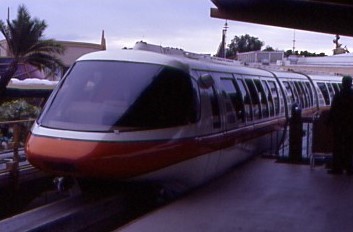
The Monorail arrived at the Tomorrowland station and we boarded for a round trip.
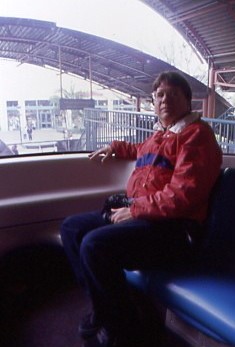
Jeff enjoying his experience.
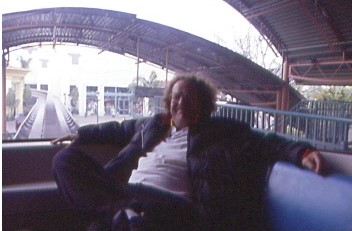
The author enjoying this unique attraction and getting some miles.
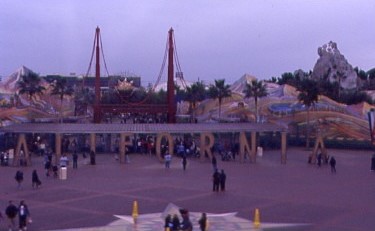
California Adventure as seen from the Monorail. After exiting the Monorail, we proceeded over there.
The present-day site of Disney California Adventure was acquired by Walt Disney in the 1950's and functioned as the parking lot of Disneyland for over 40 years. After succeeding with the multi-park business model at Walt Disney World resort in Florida, the Disney company decided to turn Walt Disney's original theme park into a multi-park resort complex as well. Disneyland was boxed-in, however, because of the growth of Anaheim around the park; while the Walt Disney World property was 30,000 acres at the time, the Disneyland site was about 400. This consisted of the park itself, the 100-acre parking lot and the newly acquired Disneyland Hotel and vacation property from the Wrather Corporation.
In 1991, Disney announced plans to build WestCOT, a west coast version of what was then known as EPCOT Center, on the site of Disneyland's parking lot. The price tag of the proposed park was high and the company was facing financial and public relation problems with the newly opened Euro Disneyland. Additionally, Disney president Frank Wells died in a helicopter crash in 1994 and these issues led Disney to cancel WestCOT in 1995. In summer 1995, Michael Eisner, Disney's CEO at the time, gathered company executives in Aspen, Colorado, to think of another idea for a second theme park in California. They broke down the Disneyland problem as follows: The majority of the people visiting Disneyland consisted primarily of California residents, locals, or those travelling from nearby states. Those who were visiting from another state or another country, probably had Disneyland as one of the several attractions to do in California.
Based on this, Disney decided it would instead build a park themed to California's history and culture to keep guests at the resort instead of going off-site. This would require less expensive hotels, a single parking garage and very little additional property acquisition, with most of the park residing on the Disneyland parking lot. Then-Disneyland president Paul Pressler relied on merchandising and retail staff instead of Imagineers to design the park. As an adult-oriented park-like Epcot, dining and shopping were the design focus. Construction of the park began on January 22, 1998 and the park's construction was accompanied by Downtown Disney and Disney's Grand Californian Hotel, in addition to renovation of the Disneyland Hotel and the re-theming of the Disneyland Pacific Hotel into Disney's Paradise Pier Hotel.
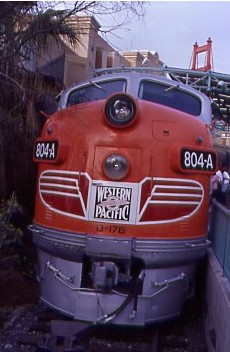
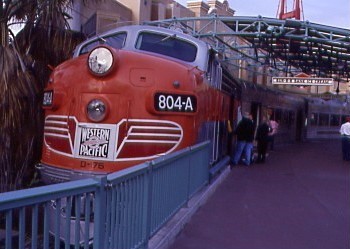
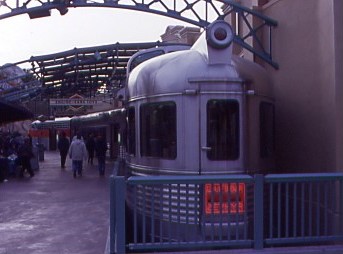
Painted in Western Pacific California Zephyr colours, this is actually the cab of Canadian National F7A 9165 1973, nee Canadian National 9104 built by General Motors Diesel, the Canadian subsidiary of the Electro Motive Division of General Motors in 1952. It was retired in 1989 and Disney’s Imagineers found it at National Railway Equipment in Dixmoor, Illinois, where it had been since 1990. The 804a was the number on the final westbound California Zephyr from Chicago when it arrived in Oakland on March 20, 1970.
The California Zephyr is a faux train that serves as a clever building façade, forming entrances to three shops. The locomotive is the entrance to Bur-r-r Bank Ice Cream, behind it, the "Silver Platter" dining car is the entrance to Baker's Field Bakery. At the rear of the train, the "Silver Crescent" Vista Dome observation car is the side entrance to Engine-Ears Toys.
Jeff and I then rode the Soaring over California ride, which was a blast.
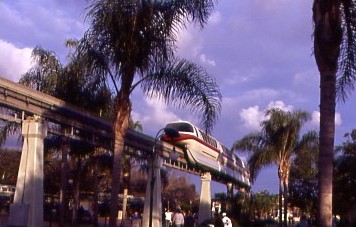
The Monorail was crossing above the two parks as we made our way to the tram and back to the car.
| RETURN TO THE MAIN PAGE |